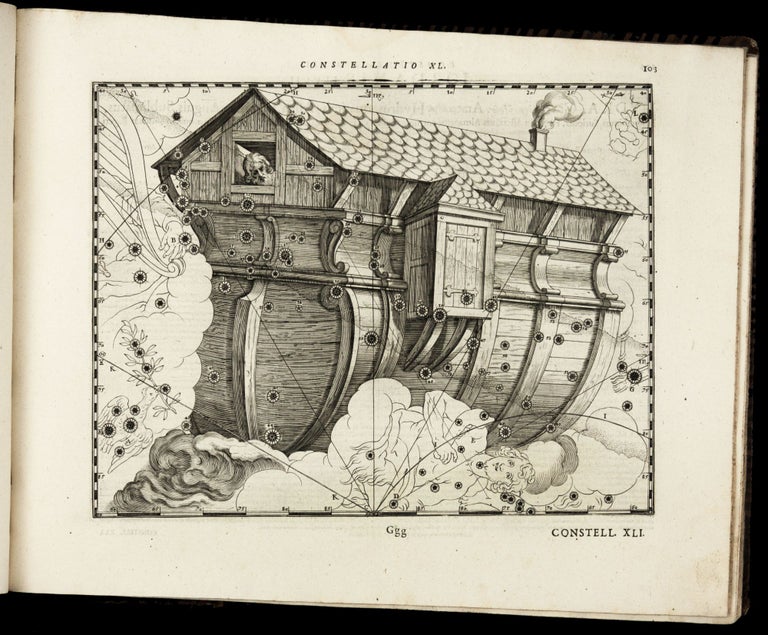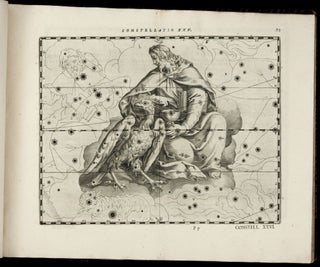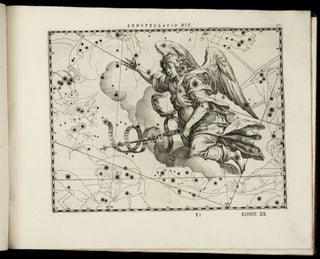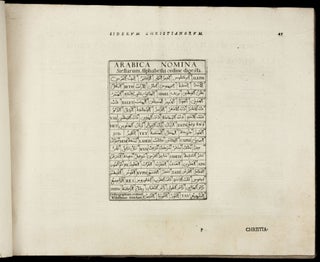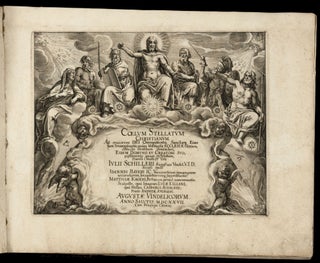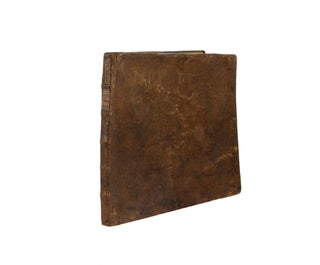Coelum Stellatum Christianum.
Oblong folio [320 x 410 mm], (2) ff., 134 pp., (1) f. errata, including engraved title, engraved plate of Arabic names, (49) engraved constellation maps and (2) engraved maps of the northern and southern skies, woodcut initials and tailpiece. Bound contemporary spotted calf with single blind rule, lettering piece laid to spine, sprinkled edges. Some rubbing and edge wear to spine and boards. Closed tear to title and first leaf, marginal mends to pp. 89, 91 and errata leaf, the occasional minor marginal stain, pale dampstain in final few leaves. Only edition of this very rare celestial atlas: Schiller’s masterwork. The Coelum Stellatum Christianum presented the most recent stellar information in a completely different context, redrawing constellations with subjects from Christian iconography in place of traditional figures from classical mythology. For the signs of the zodiac, for example, Schiller substituted the Twelve Apostles, and he replaced mythological creatures with Christian saints and symbols in the northern hemisphere and Old Testament figures in the southern hemisphere. Nor was Schiller’s atlas of merely iconographical importance: “He improved Johann Bayer’s Uranometria on the basis of Johannes Kepler’s Tabulae Rudolphinae, both correcting stars’ positions and adding stars that Bayer omitted in his atlas" (Neri, 1023). “Viewed simply as a collection of celestial maps it was the best available until Hevelius published his atlas 60 years later. Schiller was not himself an astronomer, but a cartographer who used the observations of others. His atlas, essentially a revision of Bayer’s Uranometria, was based on the latest – the most extensive and the most accurate – astronomical information. Among his authorities were Tyco Brahe, Franciscus Pissero’s revision of Tycho’s catalog as published by Grienberger, Galileo’s telescopic observations of the Pleiades, and Simon Marius’ telescopic observations of the Andromeda nebula ... “Schiller’s atlas was the outcome of the ideas and work of several men, extending over a quarter of a century. The need for a new atlas, with revised star positions and constellations, was discussed by Bayer, Schiller, and Raymond Minderer, a doctor of medicine also of Augsburg. Bayer then undertook the astronomical revisions while Schiller, in correspondence with Jesuits Johann Baptist Cysat, Paul Guldin, and Mattew Rader, converted the Greco-Roman constellations into Judeo-Christian ones. Wilhelm Schickard, the astronomer and professor of Oriental languages at Tübingen, supplied the Arabic letters and star and constellation names. Kaspar Schecks positioned the stars on the copper plates, Johann Mathias Kager drew the constellation figures, and Lucas Kilian engraved them. Finally Jacob Bartsch supplied various astronomical tables and, after Schiller’s death, supervised publication” (Warner, p. 232). Among the most notable scientific advances contained in this work is Schiller’s illustration of the great nebula in Andromeda, now known as M 31. This object was not noted by Ptolemy nor any European medieval nor Renaissance astronomer whose work followed from his. Schiller probably learned of this nebula from Simon Marius, who announced his discovery of it through the newly invented telescope on Dec. 15, 1612, in his Mundus Jovialis (Nuremberg, 1614). *Warner, Sky Explored, p. 229-32; Zinner 5078; Brown, pp. 31-33; D. Neri, Bib. Encyclopedia of Astronomers, vol. II, p. 1023.
Sold

